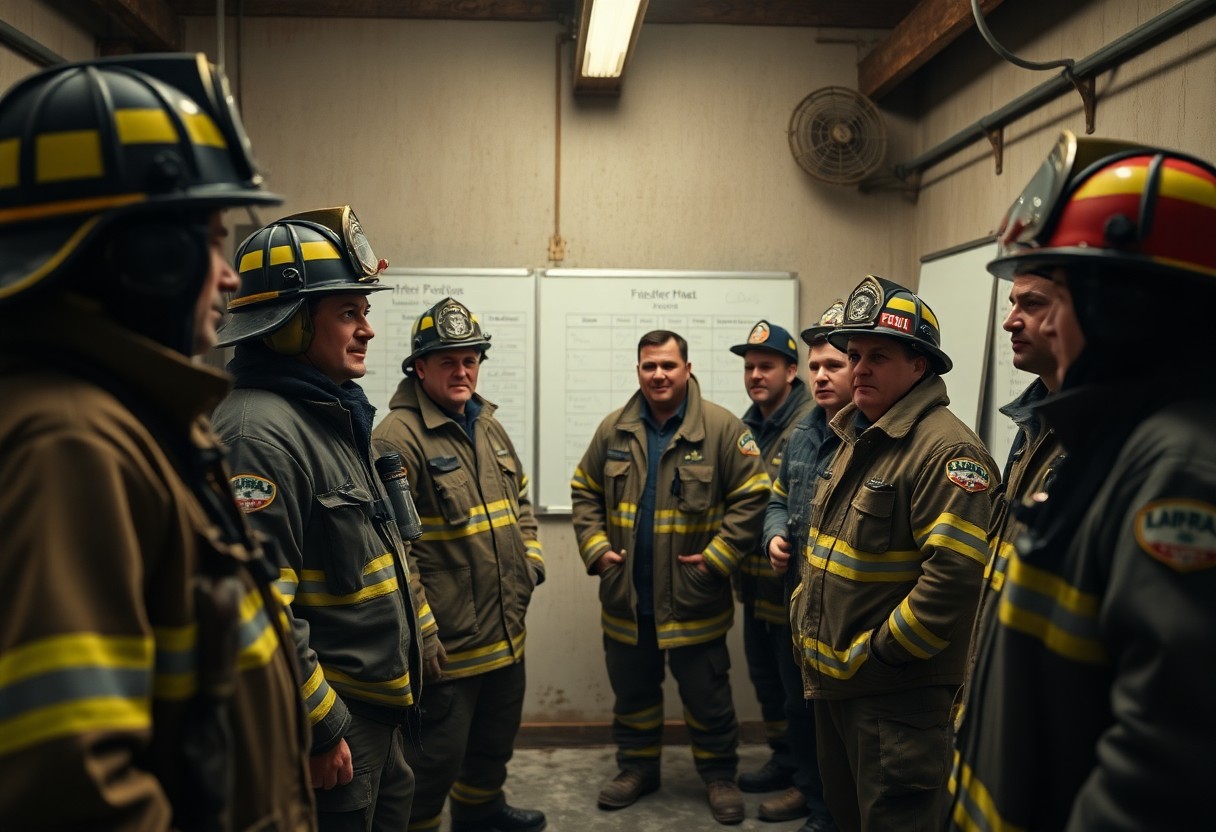Over time, you may encounter leadership conflicts within your volunteer fire company that can disrupt teamwork and undermine the mission you all share. It’s vital to address these issues with effective communication and collaborative problem-solving strategies to ensure a cohesive team environment. By understanding various conflict resolution techniques and applying them judiciously, you can foster a culture of respect and accountability, ultimately enhancing your company’s performance and morale. This guide will provide you with practical steps to skillfully navigate and resolve conflicts surrounding leadership in your organization.
Understanding Leadership Conflicts
Your ability to navigate leadership conflicts within your volunteer fire company is imperative for maintaining a positive work environment and ensuring the efficient functioning of the team. Understanding the dynamics of these conflicts allows you to address issues proactively and promote a cohesive, collaborative atmosphere. Recognizing the underlying causes and key players will empower you to implement effective conflict resolution strategies, ultimately benefiting both your team and the community you serve.
Common Causes of Conflict
The most frequent sources of conflict in volunteer fire companies often stem from differences in communication styles, varying levels of commitment, and competing priorities. These conflicts can surface due to misinterpretations or a lack of clarity in roles and responsibilities, leading to frustration among team members and an overall breakdown in teamwork.
Identifying Key Players
If you want to effectively address leadership conflicts, it is imperative to identify the key players involved in the situation. Understanding each person’s influence, perspectives, and concerns will help you facilitate open dialogue and find common ground.
Another important aspect of identifying key players is recognizing the roles they play within your volunteer fire company. From established leaders to newer members, each individual brings their own perspectives and interests to the table. Engaging those who may be most affected by conflicts can lead to insightful discussions and foster a sense of ownership in the decision-making process. Additionally, keep an eye on potential allies and detractors, as their involvement can significantly shape the outcome of conflict resolution efforts.
How to Address Conflicts
If you find yourself facing a conflict within your volunteer fire company, it’s vital to approach it with a structured mindset. Begin by acknowledging the issues at hand and ensure all relevant parties feel heard. This openness sets the stage for a constructive dialogue that fosters resolution instead of further discord.
Effective Communication Strategies
Any effective strategy starts with clear and open communication. Make it a priority to listen actively to all viewpoints involved in the conflict. Use “I” statements to express your feelings and concerns without sounding accusatory. This approach promotes a sense of safety and encourages collaboration toward a shared resolution.
Conflict Resolution Techniques
Clearly, employing the right techniques is critical to navigate conflicts effectively. Consider using mediation, where a neutral third party facilitates the discussion, allowing everyone to voice their opinions freely. This method can dissolve tension and foster understanding between competing viewpoints.
Effective conflict resolution techniques can transform disputes into opportunities for growth. Techniques such as active listening and collaborative problem-solving not only address the immediate issue but also nurture a positive culture within your team. Engaging in respectful dialogue encourages an atmosphere where members feel valued. Additionally, establishing ground rules for discussions can mitigate escalation, promoting a focus on finding solutions rather than assigning blame. These strategies contribute significantly to maintaining harmony and unity in your volunteer fire company.
Tips for Maintaining Team Cohesion
Some key strategies for maintaining strong team cohesion in your volunteer fire company include:
- Fostering a culture of respect
- Encouraging collaboration
- Recognizing individual contributions
- Promoting shared goals
Assume that by integrating these practices, your team will work more harmoniously and efficiently towards common objectives.
Building Trust Among Members
One effective way to build trust among members is to establish clear expectations and accountability. When everyone knows their roles and responsibilities, it fosters a sense of reliability, encouraging team members to depend on one another.
Encouraging Open Dialogue
To maintain harmony and enhance cooperation, it’s necessary to encourage open dialogue within your team. When individuals feel free to express their thoughts and concerns, it creates an environment of transparency.
Building a culture of openness involves actively listening to your members and valuing their input. When you allow for candid conversations, your team can address issues before they escalate into deeper conflicts. Regularly scheduled meetings can provide platforms for sharing ideas and feedback. Ensure that all voices are heard, as this reinforces that every member matters. This kind of environment not only promotes team cohesion but also leads to positive outcomes in critical situations. The more you foster this open exchange, the more likely your team will feel united and prepared to tackle challenges together.
Factors to Consider in Conflict Management
Once again, understanding how to effectively manage conflict in your volunteer fire company involves several vital factors. Consider the following aspects:
- Team Dynamics
- Organizational Culture
- Communication Styles
- Prioritizing Goals
- Emotional Intelligence
Any successful resolution relies on assessing these elements and tailoring your approach accordingly.
Understanding Team Dynamics
An effective leader must grasp the underlying team dynamics at play within your volunteer fire company. This knowledge allows you to identify individual strengths, weaknesses, and how they influence group interactions. Recognizing these aspects can facilitate better collaboration and reduce the likelihood of conflicts.
Recognizing Organizational Culture
For any organization, having a strong sense of organizational culture shapes how members communicate and relate to one another. A positive culture fosters trust and openness, allowing conflicts to be addressed quickly. In contrast, a toxic culture can result in misunderstandings and escalation of issues.
Dynamics within your fire company significantly impact conflict management strategies. A positive culture encourages teamwork, where members feel valued and understood. In contrast, a negative culture might allow gossip and power struggles to thrive, hindering effective communication. It’s vital that you cultivate a healthy culture where open dialogue is encouraged, as this creates a more resilient organization better equipped to handle conflicts proactively.
Monitoring and Evaluating Outcomes
After navigating leadership conflicts within your volunteer fire company, it is crucial to monitor and evaluate the outcomes of your conflict resolution efforts. Continuous assessment allows you to identify whether your strategies have improved team dynamics and overall performance. By keeping an eye on the situation, you ensure that any lingering issues are addressed promptly, fostering a healthier organizational culture.
Assessing Conflict Resolution Effectiveness
Effectiveness in resolving conflicts can be measured through various key performance indicators such as team cohesion, response times, and overall morale. Evaluating these aspects over time will provide insights into whether your conflict resolution strategies are producing the desired results and sustaining a positive environment.
Gathering Feedback from Team Members
From team members, gathering feedback is an instrumental part of the monitoring process. Engaging your team in open discussions can reveal how they feel about the resolution and whether they have encountered any residual issues. This feedback serves as a valuable tool in fine-tuning your approach to conflict resolution.
Outcomes from feedback sessions can significantly inform your leadership strategy. You should actively encourage team members to share their experiences, allowing for open dialogue about any remaining concerns. Consider the context of their feedback; it’s important to look for patterns or repeated issues. Value positive aspects, as they can indicate what is working well. Conversely, be sure to address any dangerous trends that may jeopardize team cohesion or performance. Ultimately, maintaining an ongoing conversation about conflict resolution within your fire company is key to sustaining a positive atmosphere.
Continuous Improvement Strategies
All leadership conflicts within your volunteer fire company offer opportunities for growth and enhancement. By implementing continuous improvement strategies, you can foster a culture that embraces collaboration, encourages open communication, and focuses on collective success. Proactively seeking feedback and refining processes will empower your team and ensure that conflicts are not only resolved but also serve as a catalyst for positive change.
Learning from Past Conflicts
Learning from past conflicts is vital for your development as a leader. Conducting thorough reflections on previous disputes can unveil underlying patterns, helping you identify issues that may recur. By engaging your team in these discussions, you create a shared understanding and pave the way for innovative solutions, ensuring that history does not repeat itself.
Training for Future Leadership
For effective leadership development, it is vital to invest in training that prepares you for future challenges. This training should focus on enhancing your conflict resolution skills, decision-making capabilities, and emotional intelligence.
Future training programs should include hands-on exercises and scenario-based learning to elevate your understanding of team dynamics and leadership styles. Incorporating role-playing sessions can significantly sharpen your ability to navigate conflicts. By developing effective communication techniques, you position yourself as a trusted leader who can foster a positive environment, ensuring all members of your fire company are equipped to handle conflicts constructively and collaboratively.
Conclusion
The ability to navigate leadership conflicts in your volunteer fire company will significantly enhance your team’s effectiveness and morale. By actively listening, fostering open communication, and encouraging collaboration, you create a more cohesive environment. Emphasize shared goals and mutual respect to turn conflicts into opportunities for growth. By applying these practices, you not only resolve disputes constructively but also strengthen your leadership skills, ensuring a more united and efficient team working towards a common mission.
FAQ
Q: What are the common sources of leadership conflicts in a volunteer fire company?
A: Leadership conflicts in a volunteer fire company often stem from differing communication styles, varying levels of commitment, and differing visions for the company’s future. Additionally, generational differences among members, personal grievances, or challenges in balancing the responsibilities of volunteer duties with personal lives can also create friction. Acknowledging these sources can aid in addressing them effectively.
Q: How can effective communication help in resolving leadership conflicts?
A: Effective communication is imperative in resolving conflicts as it fosters a culture of openness and understanding among members. Utilizing active listening techniques allows leaders to fully understand the concerns and perspectives of others. Regularly scheduled meetings and encouraging feedback can help clarify misunderstandings before they escalate. Asharing of thoughts in a respectful manner paves the way for collaborative problem-solving and maintaining transparency within the team.
Q: What steps can be taken to create a more cohesive leadership team in a volunteer fire company?
A: Creating a cohesive leadership team involves several strategies. Firstly, establishing clear roles and responsibilities among leaders helps delineate authority and minimize overlap that can lead to conflict. Secondly, team-building activities can strengthen relationships and promote trust among members. Lastly, incorporating regular training and development opportunities equips leaders with the skills needed to handle conflicts more effectively and promotes a positive environment for collaboration.



